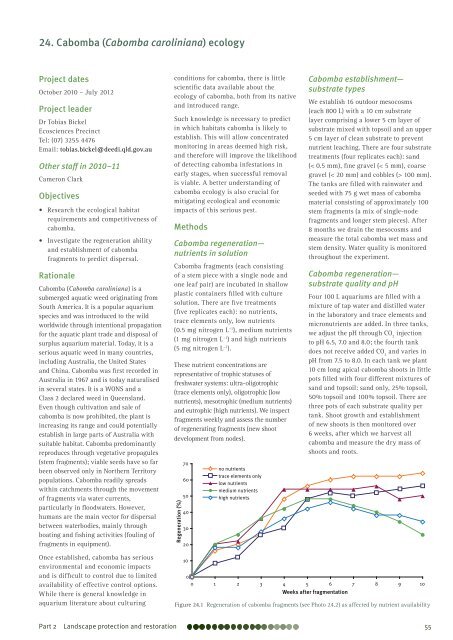Technical highlights - Department of Primary Industries ...
Technical highlights - Department of Primary Industries ...
Technical highlights - Department of Primary Industries ...
Create successful ePaper yourself
Turn your PDF publications into a flip-book with our unique Google optimized e-Paper software.
24. Cabomba (Cabomba caroliniana) ecology<br />
Project dates<br />
October 2010 – July 2012<br />
Project leader<br />
Dr Tobias Bickel<br />
Ecosciences Precinct<br />
Tel: (07) 3255 4476<br />
Email: tobias.bickel@deedi.qld.gov.au<br />
Other staff in 2010–11<br />
Cameron Clark<br />
Objectives<br />
• Research the ecological habitat<br />
requirements and competitiveness <strong>of</strong><br />
cabomba.<br />
• Investigate the regeneration ability<br />
and establishment <strong>of</strong> cabomba<br />
fragments to predict dispersal.<br />
Rationale<br />
Cabomba (Cabomba caroliniana) is a<br />
submerged aquatic weed originating from<br />
South America. It is a popular aquarium<br />
species and was introduced to the wild<br />
worldwide through intentional propagation<br />
for the aquatic plant trade and disposal <strong>of</strong><br />
surplus aquarium material. Today, it is a<br />
serious aquatic weed in many countries,<br />
including Australia, the United States<br />
and China. Cabomba was first recorded in<br />
Australia in 1967 and is today naturalised<br />
in several states. It is a WONS and a<br />
Class 2 declared weed in Queensland.<br />
Even though cultivation and sale <strong>of</strong><br />
cabomba is now prohibited, the plant is<br />
increasing its range and could potentially<br />
establish in large parts <strong>of</strong> Australia with<br />
suitable habitat. Cabomba predominantly<br />
reproduces through vegetative propagules<br />
(stem fragments); viable seeds have so far<br />
been observed only in Northern Territory<br />
populations. Cabomba readily spreads<br />
within catchments through the movement<br />
<strong>of</strong> fragments via water currents,<br />
particularly in floodwaters. However,<br />
humans are the main vector for dispersal<br />
between waterbodies, mainly through<br />
boating and fishing activities (fouling <strong>of</strong><br />
fragments in equipment).<br />
Once established, cabomba has serious<br />
environmental and economic impacts<br />
and is difficult to control due to limited<br />
availability <strong>of</strong> effective control options.<br />
While there is general knowledge in<br />
aquarium literature about culturing<br />
conditions for cabomba, there is little<br />
scientific data available about the<br />
ecology <strong>of</strong> cabomba, both from its native<br />
and introduced range.<br />
Such knowledge is necessary to predict<br />
in which habitats cabomba is likely to<br />
establish. This will allow concentrated<br />
monitoring in areas deemed high risk,<br />
and therefore will improve the likelihood<br />
<strong>of</strong> detecting cabomba infestations in<br />
early stages, when successful removal<br />
is viable. A better understanding <strong>of</strong><br />
cabomba ecology is also crucial for<br />
mitigating ecological and economic<br />
impacts <strong>of</strong> this serious pest.<br />
Methods<br />
Cabomba regeneration—<br />
nutrients in solution<br />
Cabomba fragments (each consisting<br />
<strong>of</strong> a stem piece with a single node and<br />
one leaf pair) are incubated in shallow<br />
plastic containers filled with culture<br />
solution. There are five treatments<br />
(five replicates each): no nutrients,<br />
trace elements only, low nutrients<br />
(0.5 mg nitrogen L –1 ), medium nutrients<br />
(1 mg nitrogen L –1 ) and high nutrients<br />
(5 mg nitrogen L –1 ).<br />
These nutrient concentrations are<br />
representative <strong>of</strong> trophic statuses <strong>of</strong><br />
freshwater systems: ultra-oligotrophic<br />
(trace elements only), oligotrophic (low<br />
nutrients), mesotrophic (medium nutrients)<br />
and eutrophic (high nutrients). We inspect<br />
fragments weekly and assess the number<br />
<strong>of</strong> regenerating fragments (new shoot<br />
development from nodes).<br />
Regeneration (%)<br />
70<br />
60<br />
50<br />
40<br />
30<br />
20<br />
10<br />
no nutrients<br />
trace elements only<br />
low nutrients<br />
medium nutrients<br />
high nutrients<br />
Cabomba establishment—<br />
substrate types<br />
We establish 16 outdoor mesocosms<br />
(each 800 L) with a 10 cm substrate<br />
layer comprising a lower 5 cm layer <strong>of</strong><br />
substrate mixed with topsoil and an upper<br />
5 cm layer <strong>of</strong> clean substrate to prevent<br />
nutrient leaching. There are four substrate<br />
treatments (four replicates each): sand<br />
(< 0.5 mm), fine gravel (< 5 mm), coarse<br />
gravel (< 20 mm) and cobbles (> 100 mm).<br />
The tanks are filled with rainwater and<br />
seeded with 75 g wet mass <strong>of</strong> cabomba<br />
material consisting <strong>of</strong> approximately 100<br />
stem fragments (a mix <strong>of</strong> single-node<br />
fragments and longer stem pieces). After<br />
8 months we drain the mesocosms and<br />
measure the total cabomba wet mass and<br />
stem density. Water quality is monitored<br />
throughout the experiment.<br />
Cabomba regeneration—<br />
substrate quality and pH<br />
Four 100 L aquariums are filled with a<br />
mixture <strong>of</strong> tap water and distilled water<br />
in the laboratory and trace elements and<br />
micronutrients are added. In three tanks,<br />
we adjust the pH through CO 2 injection<br />
to pH 6.5, 7.0 and 8.0; the fourth tank<br />
does not receive added CO 2 and varies in<br />
pH from 7.5 to 8.0. In each tank we plant<br />
10 cm long apical cabomba shoots in little<br />
pots filled with four different mixtures <strong>of</strong><br />
sand and topsoil: sand only, 25% topsoil,<br />
50% topsoil and 100% topsoil. There are<br />
three pots <strong>of</strong> each substrate quality per<br />
tank. Shoot growth and establishment<br />
<strong>of</strong> new shoots is then monitored over<br />
6 weeks, after which we harvest all<br />
cabomba and measure the dry mass <strong>of</strong><br />
shoots and roots.<br />
0<br />
0 1 2 3 4 5 6 7 8 9 10<br />
Weeks after fragmentation<br />
Figure 24.1 Regeneration <strong>of</strong> cabomba fragments (see Photo 24.2) as affected by nutrient availability<br />
Part 2 Landscape protection and restoration 55

















